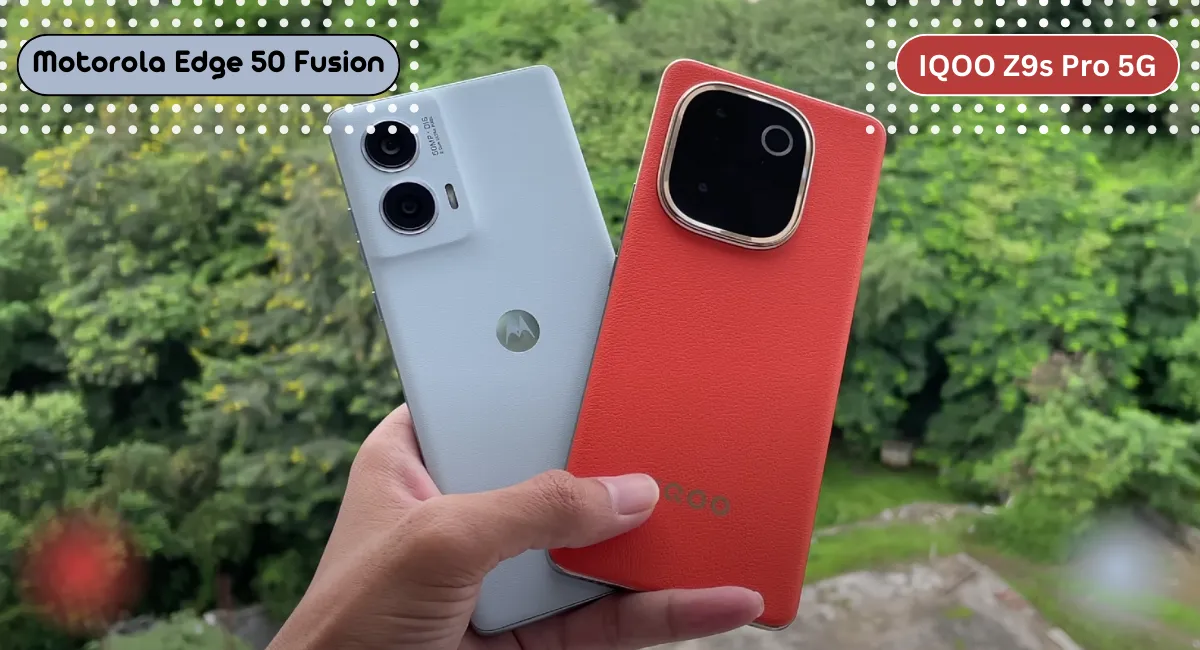After spending considerable time with the recently launched IQOO Z9s Pro 5G and the Motorola Edge 50 Fusion, which was launched three months ago, we decided to do an in-depth comparison between them. Both smartphones fall under the ₹25,000 price range, a highly competitive market segment.
Now, the question is: which one stands out in this category? Both smartphones have their strengths and weaknesses, which we will analyze in detail. We’ll be testing the display, camera, and real-life performance, along with scores from popular benchmark platforms and more. Are you excited? I’m really very excited! Let’s start the battle between these two smartphones.
Wait, wait, wait… let me tell you about the pricing first. The IQOO Z9s Pro 5G is normally priced at ₹24,999, but with a card discount, you can get it for ₹22,999. On the other hand, the Motorola Edge 50 Fusion is available for ₹22,999. We are discussing the price of base variants with 8GB of RAM and 128GB of storage. Get ready to see the battle!
IQOO Z9s Pro 5G vs Motorola Edge 50 Fusion – Specs
| Specs Compare | IQOO Z9s Pro 5G | Moto Edge 50 Fusion |
|---|---|---|
| Dimensions | 163.72 x 75 x 7.99 mm | 162 x 73.1 x 7.9mm |
| Weight | 190g | 175g |
| IP Rating | IP64 | IP68 |
| Display | 6.77-inch 3D curved AMOLED, 120Hz refresh rate, 1080 x 2400 pixels resolution & 4500 nits peak brightness | 6.67-inch 3D curved p-OLED, 144Hz refresh rate, 1080 x 2400 pixels resolution & 1800 nits peak brightness |
| Processor | Qualcomm SM7550-AB Snapdragon 7 Gen 3 (TSMC 4nm) | Qualcomm SM7435-AB Snapdragon 7s Gen 2 (4nm) |
| CPU | Octa-core (1x Cortex-A715 @2.63GHz & 3x Cortex-A715 @2.4GHz & 4x Cortex-A510 @1.8GHz) | Octa-core (4x Cortex-A78 @2.4GHz & 4x Cortex-A55 @1.95GHz) |
| GPU | Adreno 720 | Adreno 710 |
| Rear Camera | 50 MP (Primary) + 8 MP (120° UW) + Flicker sensor, OIS+EIS | 50 MP (Primary) + 13 MP (120° UW), OIS+EIS |
| Front Camera | 16 MP | 32 MP |
| Video Recording | 1080p @30/60fps, 4k @30fps | 1080p @30/60/120fps, 4k @30fps |
| Memory | RAM – LPDDR4X, 8GB/12GB Storage – UFS 2.2 128GB/256GB | RAM – LPDDR4X, 8GB/12GB Storage – UFS 2.2 128GB/256GB |
| Battery and Charging | 5500 mAh battery with 80W charging | 5000 mAh battery with 68W charging |
| Connectivity | 8 5G bands, Wi-Fi 6, Bluetooth 5.4, NFC not supported | 13 5G bands, Wi-Fi 5, Bluetooth 5.2, NFC supported |
| Software | Funtouch OS 14.0, Android V14, 2+3 update policy | Hello UI, Android V14, 3+4 update policy |
| Speaker | Dual stereo speakers with Hi-Res audio support | Dual stereo speakers with Dolby Atmos audio support |
IQOO Z9s Pro 5G vs Motorola Edge 50 Fusion – Design and Build
Both the Motorola and IQOO smartphones feature a premium design with a vegan leather and polycarbonate back panel and a plastic frame. The Motorola offers three color variants: Forest Blue, Marshmallow Blue, and Hot Pink, while the IQOO comes with two color options: Flamboyant Orange and Luxe Marble.
We are currently using the Motorola Marshmallow Blue and IQOO Flamboyant Orange smartphones, both featuring vegan leather. The Motorola is slightly smaller and lighter than the IQOO, making it more comfortable to hold. In terms of protection, the Motorola has a higher IP68 rating for water and dust resistance compared to the IQOO’s IP64 rating.
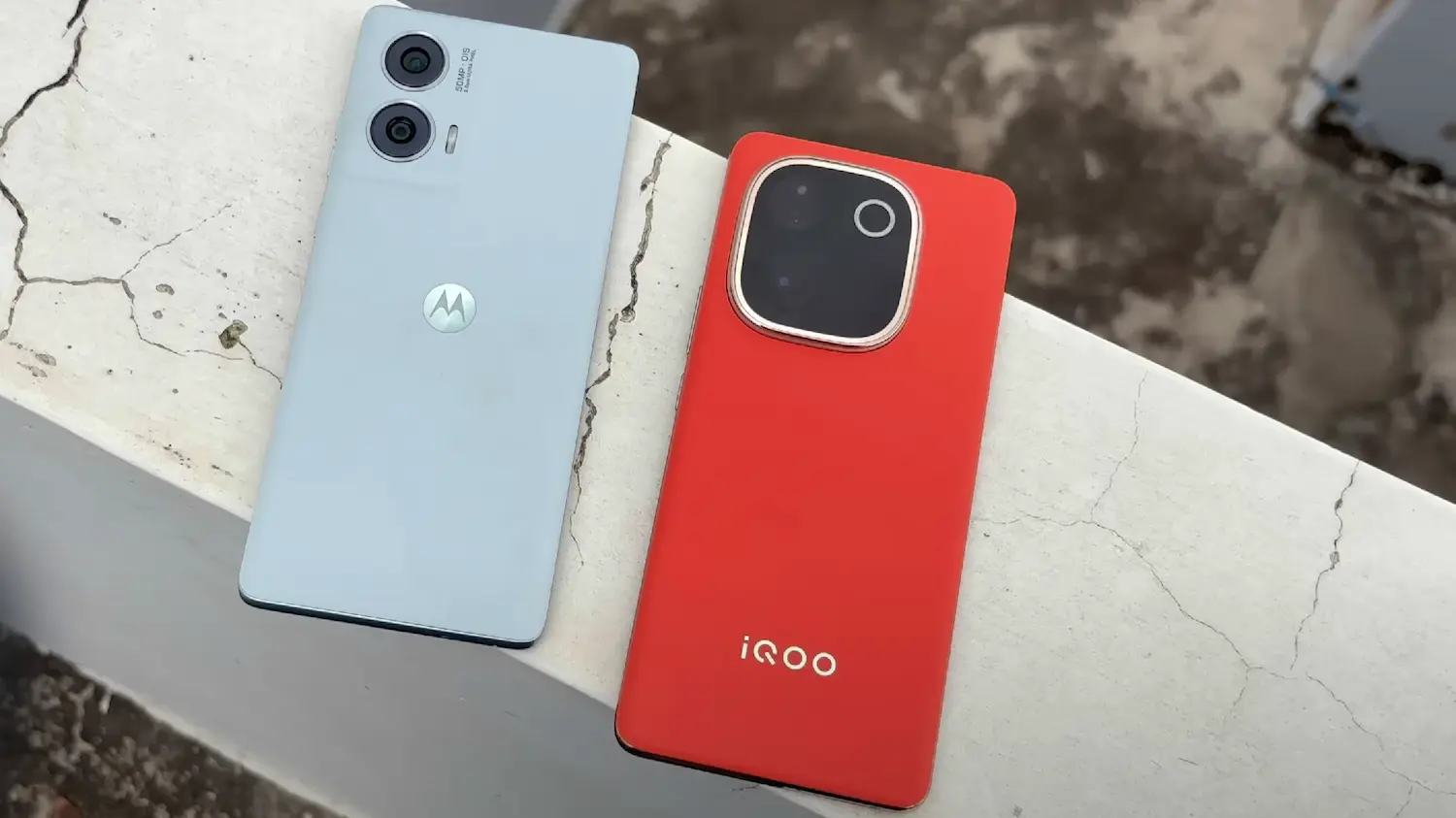
Both smartphones feel good in the hand, but the Motorola Edge 50 Fusion’s design feels boring as it has been used for most “Moto” devices for the past few years. On the other hand, the IQOO Z9s Pro 5G features the flagship IQOO 12’s design, giving it a more premium experience.
Since the two smartphones use different materials, the polycarbonate panel on the IQOO has a glossy finish that shows fingerprints, whereas the polycarbonate panel (PMMA) on the Motorola has a matte finish that doesn’t retain fingerprints. If you’re considering the vegan leather options, you won’t have to worry about fingerprints on either device.
IQOO Z9s Pro 5G vs Motorola Edge 50 Fusion – Display
Both smartphones offer large displays, with IQOO boasting a 6.77-inch panel while Motorola features a 6.7-inch screen. Both incorporate 3D curved panels for a more immersive viewing experience. Protection-wise, IQOO utilizes SCHOTT Xensation-Alpha glass, whereas Motorola opts for Corning Gorilla Glass 5. Motorola edges out in refresh rate with a 144Hz display, compared to IQOO’s 120Hz panel. Both smartphones have impressive screen-to-body ratios above 90%, giving them almost bezel-less displays.
When it comes to OTT platforms, the IQOO takes the lead due to its HDR10 and HDR10+ certifications, offering a richer viewing experience, while Motorola only supports HDR playback. The IQOO’s display feels brighter indoors due to its 4500 nits peak brightness, compared to Motorola’s 1800 nits. Outdoors, there isn’t much of a difference, as both displays are quite visible, though the IQOO slightly edges out.

It has been observed that the IQOO smartphone experiences frame drops and jitteriness during 4K video playback on YouTube, which affects the smoothness of the video. In contrast, the Motorola smartphone handles 4K video playback smoothly without such issues. However, it’s important to note that while Motorola does not support HDR on YouTube, IQOO does.
During video playback, Motorola tends to slightly boost the colors of objects, which some might prefer. In contrast, the IQOO tries to keep colors closer to their natural appearance. Overall, it’s fair to say that the IQOO generally has the advantage in terms of display quality, although Motorola still offers a commendable viewing experience.
IQOO Z9s Pro 5G vs Motorola Edge 50 Fusion – Performance
In terms of performance, there is a significant difference between these two smartphones. We know that IQOO smartphones are renowned for delivering heavy performance at a lower price, and that’s why the IQOO Z9s Pro 5G features Qualcomm’s powerful Snapdragon 7 Gen 3 chipset. On the other hand, the Motorola Edge 50 Fusion is equipped with the Snapdragon 7s Gen 2 chip. Both smartphones are available in 8GB/12GB RAM and 128GB/256GB storage variants, and they both come with LPDDR4X RAM and UFS 2.2 storage support.

I don’t understand why smartphones are still so focused on DDR4X and UFS 2.2. Standing in 2024, we see the same versions in almost all mid-range smartphones. At least UFS 3.1 should be provided. In the era of DDR5X and UFS 4.0, using these older versions is truly disappointing. Anyway, let’s try to capture their performance through benchmark scores and real-life usage.
Benchmark
We used the 12GB + 256GB variants of both smartphones to extract their highest benchmark scores. For benchmarking, we relied on popular platforms like AnTuTu and Geekbench. We also conducted a 15-minute extreme CPU throttling test. Additionally, storage tests and video rendering were performed on both smartphones, which are based on the UFS 2.2 storage type.
- AnTuTu : The Z9s Pro 5G scores ~45.61% higher on AnTuTu benchmark compared to the Edge 50 Fusion.
- Geekbench : The Z9s Pro 5G demonstrates a ~16.59% higher single-core score, ~9.6% higher multi-core score, and a ~53.5% higher OpenCL score on Geekbench compared to the Edge 50 Fusion.
- CPU Throttling : Surprisingly, no CPU throttling was observed in the IQOO during this test, whereas the Motorola throttled up to 87%. Additionally, when comparing the average performance scores, the IQOO’s average GPU score is ~15.29% higher than Motorola’s.
- Storage test : Motorola Edge 50 Fusion takes the lead in this test, scoring ~11.18% higher than IQOO Z9s Pro 5G.
Note : Benchmark scores depend on many factors, such as smartphone variant, ambient temperature, whether the device is plugged in or plugged out, and other conditions. Therefore, the scores may vary depending on the smartphone.
Gaming
We tested both smartphones on BGMI for gameplay, where both smartphones unlocked the same graphics settings: Smooth + Extreme and HDR + Extreme. While both devices support 60fps gameplay, we found the Smooth + Extreme setting to be more optimal and conducted our testing using those settings. Additionally, IQOO’s 4D Game Vibration and Motion Control features enhance your gaming skills, offering a more realistic experience.
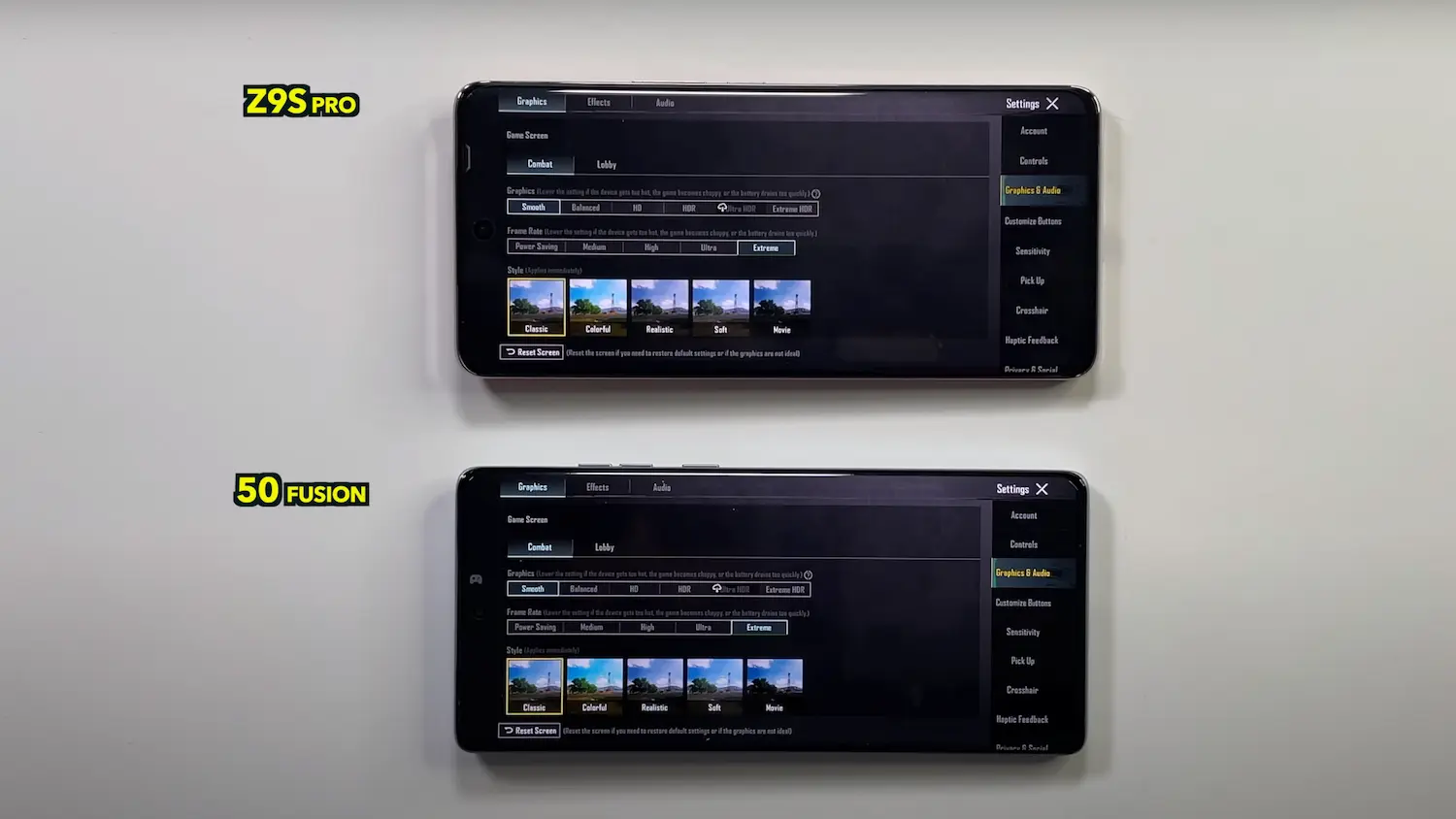
During testing, the IQOO consistently delivered a stable FPS, providing a better gaming experience with an average FPS of around 55-58. On the other hand, Motorola experienced heating issues, frame drops, and a laggy feel during extended gameplay, with an average FPS of about 43-45. IQOO’s advanced stainless steel 3000 mm² VC cooling system further ensures your device stays cool even during intense gaming sessions.
In terms of day-to-day and normal usage, both smartphones perform similarly well. RAM management, multitasking, and app opening are smoothly handled on both devices. However, when pushed with heavy usage or demanding tasks/apps, Motorola shows a performance drop, while the IQOO consistently maintains its performance. This is also reflected in the benchmark scores, where the IQOO scores ~28-30% higher than the Motorola, indicating its superior performance.
On the other hand, Motorola slightly outperforms IQOO in storage tests and KineMaster video exports. For rendering a 1080p @60fps video, Motorola completes the task in 59 seconds, while IQOO takes 1 minute 45 seconds.
IQOO Z9s Pro 5G vs Motorola Edge 50 Fusion – Battery and Charging
Is there a difference in the batteries of the two smartphones? Yes, definitely. The IQOO features a large 5500 mAh battery, while the Motorola has a 5000 mAh battery. Interestingly, despite their large battery capacities, both smartphones maintain good weight distribution, feeling slim and lightweight in hand, which I appreciate. The IQOO supports 80W wired FlashCharge for fast charging, whereas the Motorola supports 68W wired TurboPower technology.
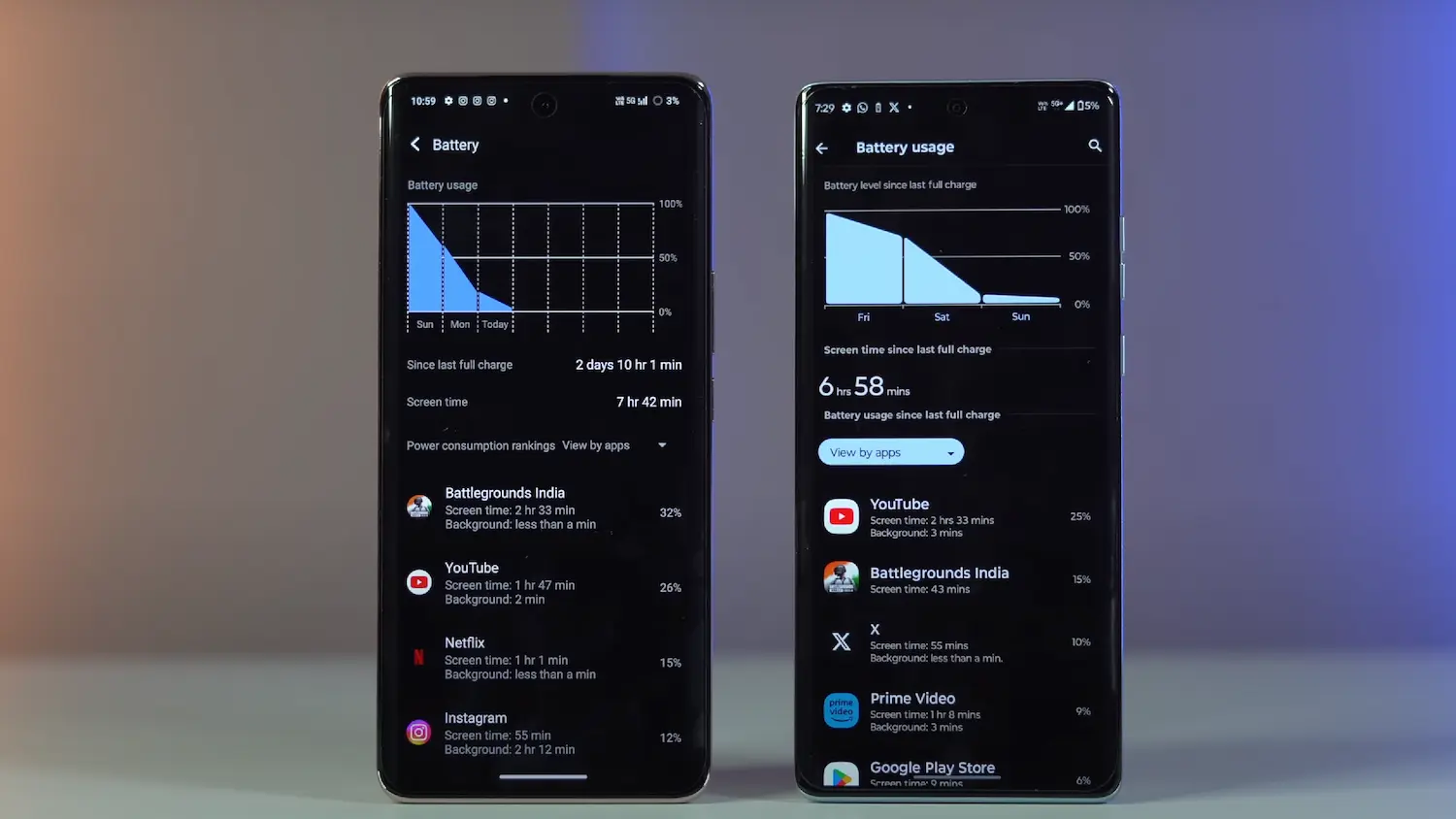
In heavy performance scenarios, the IQOO’s larger battery provides slightly better backup compared to the Motorola. The IQOO offers around 7 hours 42 minutes of Screen On Time (SOT), while the Motorola provides about 6 hours 58 minutes. Thus, you’ll get nearly an additional hour of battery life with the IQOO.
However, both smartphones easily provide a full day of battery life under normal usage. In terms of charging speed, the IQOO takes 21 minutes to charge from 0-50%, while the Motorola achieves the same charge level in just 15 minutes. This difference in charging time is likely due to the larger battery capacity of the IQOO.
IQOO Z9s Pro 5G vs Motorola Edge 50 Fusion – Camera
Both smartphones have noteworthy camera departments. On the rear side, both devices feature a 50 MP Sony sensor primary lens. Motorola is equipped with a 13 MP ultrawide 120° lens, whereas the IQOO offers an 8 MP 120° ultrawide lens. When it comes to the front-facing camera, Motorola’s 32 MP sensor is commendable compared to IQOO’s 16 MP front camera. Additionally, both smartphones support an LED flash on the back, enhancing their photography capabilities in low-light areas.
| Camera | IQOO Z9s Pro 5G | Motorola Edge 50 Fusion |
|---|---|---|
| Primary lens | 50 MP (Sony IMX882) | 50 MP (Sony LYT-700C) |
| Ultrawide | 8 MP (OmniVision OV08D10) | 13 MP (SK Hynix HI1336) |
| Seflie | 16 MP (ISOCELL 3P9SP04) | 32 MP (ISOCELL JD1) |
Both devices offer a range of features like Portrait, Panorama, Slow-motion, Time-lapse, Digital zoom, and HDR. Notably, the IQOO stands out with its 10X digital zoom compared to Motorola’s 8X digital zoom. Furthermore, while both devices offer standard camera features, the IQOO boasts additional features like an AI object remover and AI image enhancement, which are absent in the Motorola.
Photography
Both devices capture amazing pictures with their primary cameras, showing minimal differences in detailing and quality. However, there is a distinction in color representation: Motorola tends to produce images with more vibrant, punchy colors, while the IQOO delivers a more natural, realistic color palette. Some might prefer the boosted colors of the Motorola, but personally, I find the natural color rendering of the IQOO more appealing.
From the pictures, it’s evident that the IQOO has better dynamic range compared to the Motorola. While Motorola tends to add a reddish hue to human skin tones, IQOO strives to maintain a more natural appearance.
In daylight, the performance is quite close, with the IQOO excelling in some scenarios and the Motorola performing better in others. However, in low-light conditions, the Motorola shines. It captures more light and provides better detail, enhancing the overall image quality compared to the IQOO. The IQOO may show slightly darker skin tones and objects in low light.



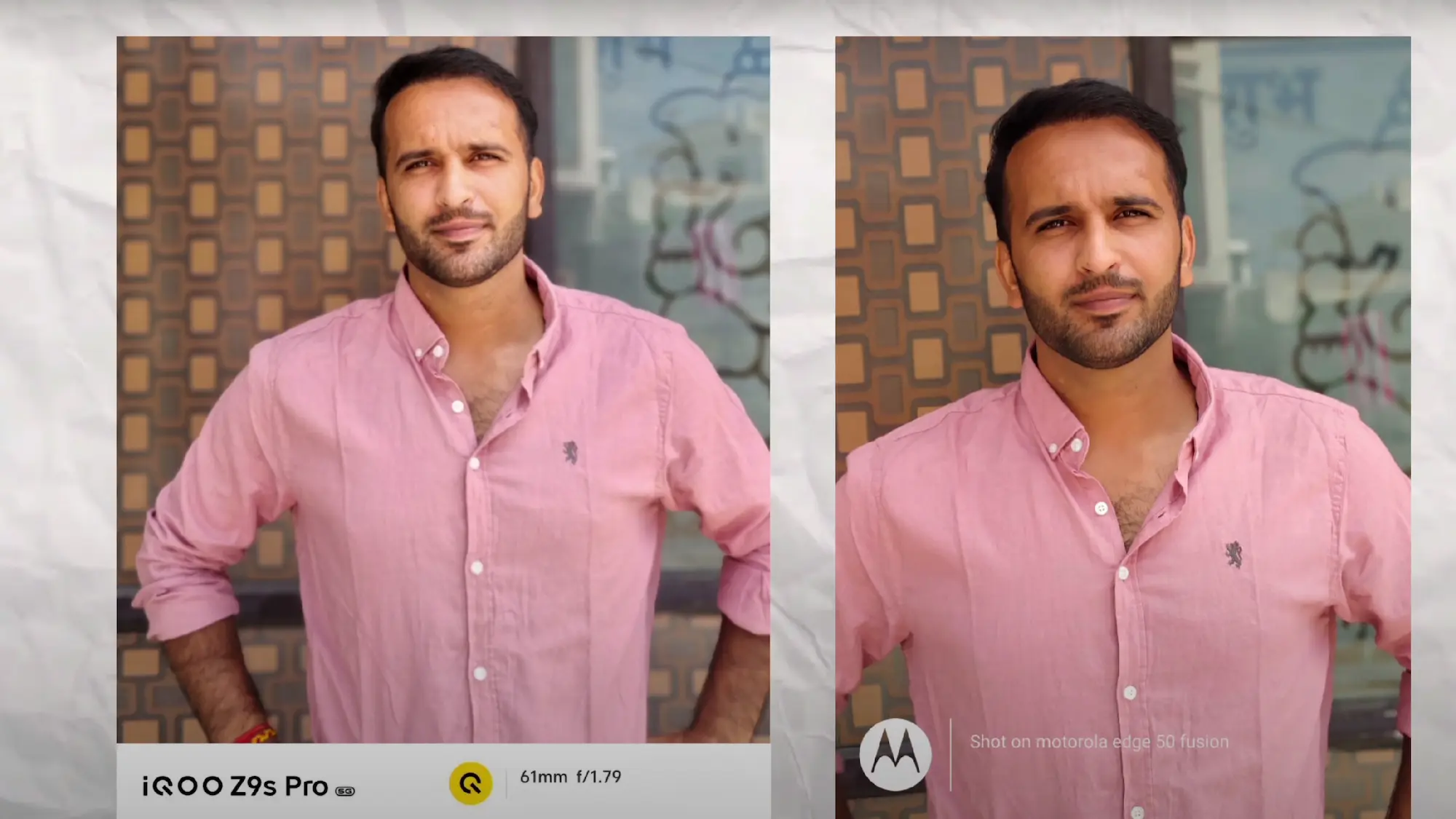



In portrait mode, both smartphones perform well, but IQOO’s edge detection is slightly better compared to Motorola. However, Motorola offers more versatility with its portrait shots, allowing you to capture photos in three different stages: 24mm, 35mm, and 50mm. On the other hand, IQOO only provides the option to shoot with a 2x zoom.
Motorola’s 13MP 120° ultra-wide lens delivers better image quality and detailing compared to IQOO’s 8MP 120° ultra-wide lens. While IQOO doesn’t take bad photos, Motorola slightly edges out in the ultra-wide segment. Additionally, Motorola’s ultra-wide lens doubles as a macro camera, whereas IQOO includes a dedicated flicker sensor on the rear instead.
You’ll notice a significant difference in the selfie cameras. Motorola’s 32MP selfie camera captures better pictures compared to IQOO’s 16MP setup. Even when shooting against sunlight, Motorola provides better results.
One thing to note is that the Motorola selfie camera sometimes produces a pinkish tone on human skin, and there can be some loss of skin details. While I personally prefer the IQOO for selfies in some situations, overall, Motorola’s selfie camera is more acceptable.
Videography
Both smartphones support 4k video recording at a maximum frame rate of 30fps with their rear cameras, while 60fps recording is only available at 1080p. They both offer stabilization through OIS and EIS, providing relatively smooth video capture. When it comes to slow-motion recording, Motorola allows 1080p at 120fps, which is a bit more advanced compared to the 720p at 120/240fps offered by IQOO.
However, each device has its shortcomings: Motorola sometimes struggles with focus issues, whereas IQOO lacks OIS at 1080p @60fps, though IQOO’s doesn’t have any focus problems. Both smartphones handle 4k @30fps video recording well, with effective stabilization.
A significant difference in the selfie camera is that Motorola can record at a higher resolution of 4k @30fps, while IQOO is limited to 1080p @30fps. However, as previously mentioned, Motorola tends to capture slightly boosted colors. Despite this, the overall video quality is quite amazing between the two, except for the differences in selfie video recording.
IQOO Z9s Pro 5G vs Motorola Edge 50 Fusion – Software
In the software department, just like in other aspects, there are notable differences that might surprise you. Both smartphones run on Android V14, with the IQOO based on Funtouch OS 14.0 and the Motorola on Hello UI. In terms of software update policy, Motorola takes the lead with 3 years of major OS updates and 4 years of security updates, compared to IQOO’s 2 years of OS updates and 3 years of security patch updates.

One important thing to keep in mind is that although Motorola offers a longer update policy—1 year more than IQOO—the update frequency is significantly lower than IQOO. For example, as of this August, we’re seeing a June security update on Motorola, while IQOO consistently delivers the latest security patches every month. This makes IQOO a better choice if you prioritize receiving the most up-to-date software and security patches regularly.
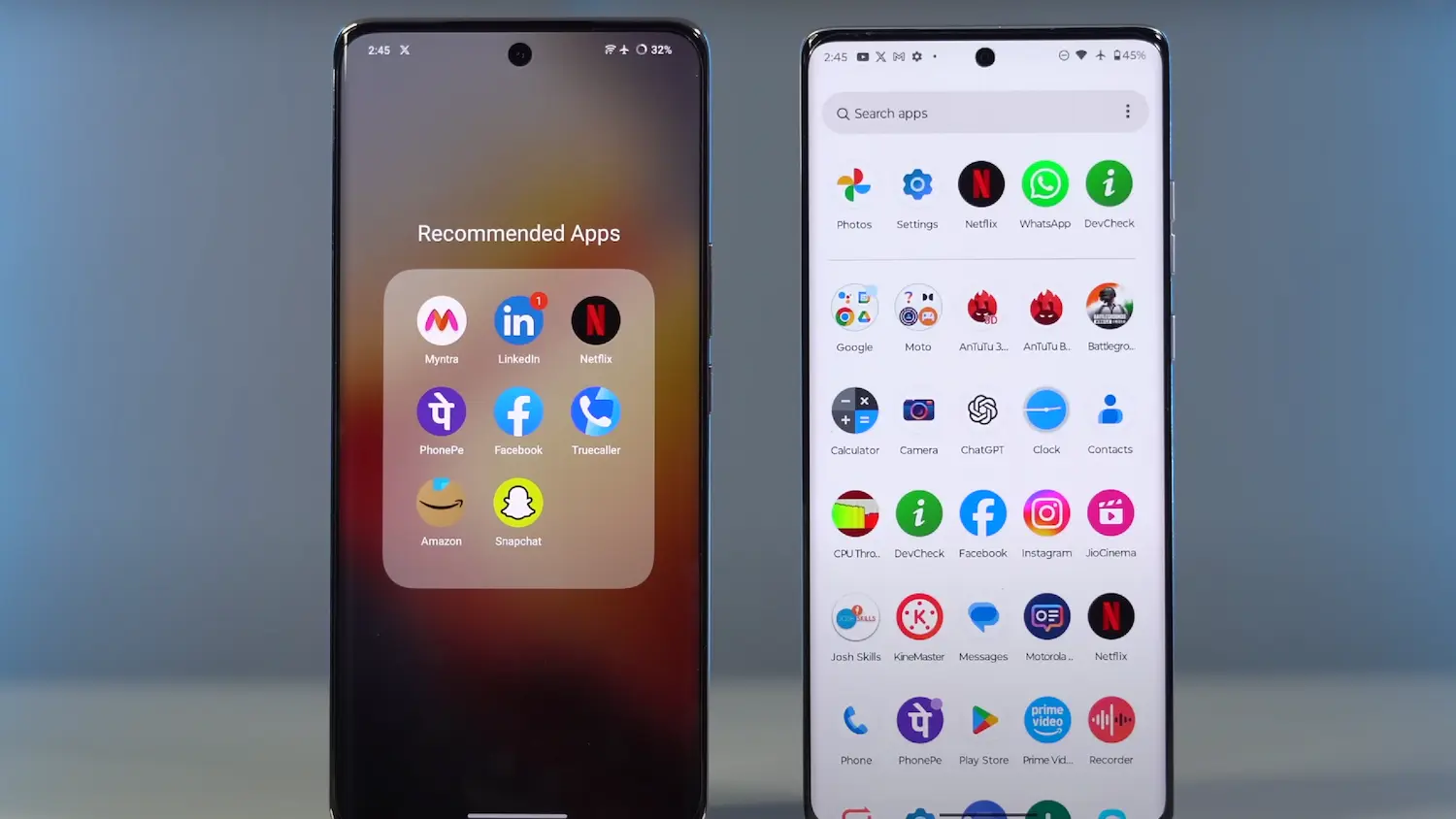
IQOO relies heavily on Vivo’s Funtouch OS, which comes with a significant amount of pre-installed bloatware and third-party applications. Additionally, apps like Hot Games, Hot Apps, V-Appstore, Theme, and Browser frequently send spam notifications.
While you can’t uninstall these apps, you can turn off notifications to avoid the annoyance (though you can disable Hot Games/Apps). On the other hand, Motorola is consistently praised for providing a near-stock Android experience with no pre-installed third-party apps. These features give Motorola an edge in offering a cleaner and better software experience.
IQOO Z9s Pro 5G vs Motorola Edge 50 Fusion – Other Features
Both smartphones come with a variety of new features. In some areas, IQOO offers more features, while in others, Motorola stands out with its own set of enhanced functionalities.
Connectivity
Neither of the two smartphones offers a microSDXC slot, so you will need to rely on the built-in storage. Both support dual nano SIM cards. In terms of 5G connectivity, IQOO offers 8 5G bands, while Motorola boasts 13 5G bands. IQOO is ahead with Wi-Fi 6 and Bluetooth V5.4, compared to Motorola’s Wi-Fi 5 and Bluetooth V5.2. IQOO offers more reliable wireless connectivity, Motorola’s Wi-Fi version could benefit from an upgrade to Wi-Fi 6.

However, Motorola includes NFC support, which is missing on the IQOO. Both phones use USB 2.0 for data transfer and charging. Data speeds are high on both, but Motorola experiences occasional Wi-Fi calling issues and call drops. On the IQOO, calls may switch to the 4G network during a 5G data connection.
Speakers, Fingerprint & Haptic
Both smartphones feature dual stereo speakers, with the Motorola supporting Dolby Atmos and the IQOO offering Hi-Res audio certification. There’s not much difference in sound clarity and loudness between the two, but Motorola delivers stronger Bass. On the other hand, the IQOO boasts 300% massive loudness. Your preference might depend on whether you prioritize stronger bass or higher loudness—I personally preferred the sound quality of the IQOO.
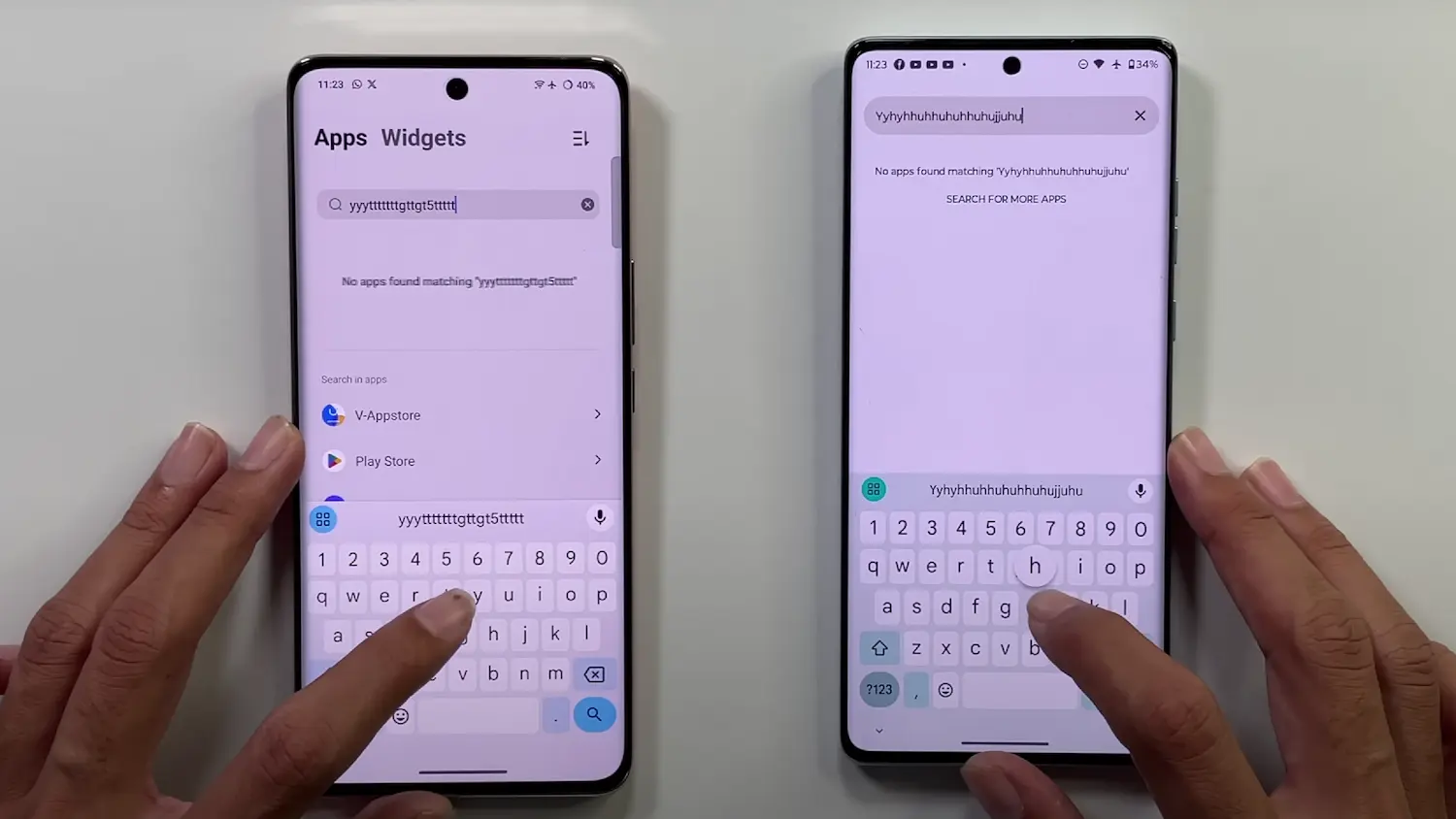
Both smartphones come with in-display fingerprint sensors, which are quite responsive. However, IQOO unlocks slightly faster compared to Motorola on the lock screen. In terms of haptic feedback, there’s no noticeable difference between the two; both use standard haptic motors that provide a satisfying “Tak…Tak” sound while typing, along with a regular vibration feel.
AI Features
Both smartphones offer unique features, but they cater to different user needs. IQOO excels in AI-driven features like AI Object Remover, AI Image Enhancement, and Wet Touch Technology, which enhance the user experience in photography and usability. These features are not available in Motorola.

On the other hand, Motorola focuses on productivity and security with features like Mobile to PC Smart Connect, Moto Secure, Family Space, and Moto Gestures. These tools make Motorola a more versatile option for users who value seamless connectivity, enhanced security, and personalized gestures.
So, while IQOO emphasizes AI and performance, Motorola leans more towards offering a secure and connected user experience.
Our Verdict
Undoubtedly, both smartphones offer compelling options within the under ₹25,000 segment, catering to specific user needs and price points. From my perspective, I would prefer the IQOO Z9s Pro 5G. While it does have some minor shortcomings compared to Motorola, especially in software and protection, these can be managed. With some time spent disabling third-party apps, turning off spam notifications, and customizing the UI, you can achieve a clean and user-friendly experience on the IQOO, making it a solid choice overall.
If you prioritize a stock Android experience, then the Motorola Edge 50 Fusion is worth considering. It offers a more secure software environment and a wider range of features not found on the IQOO. Such as better selfie images capture, 4k @60fps video recording on the front camera, and longer-term software updates, which collectively contribute to a superior user experience compared to the IQOO.
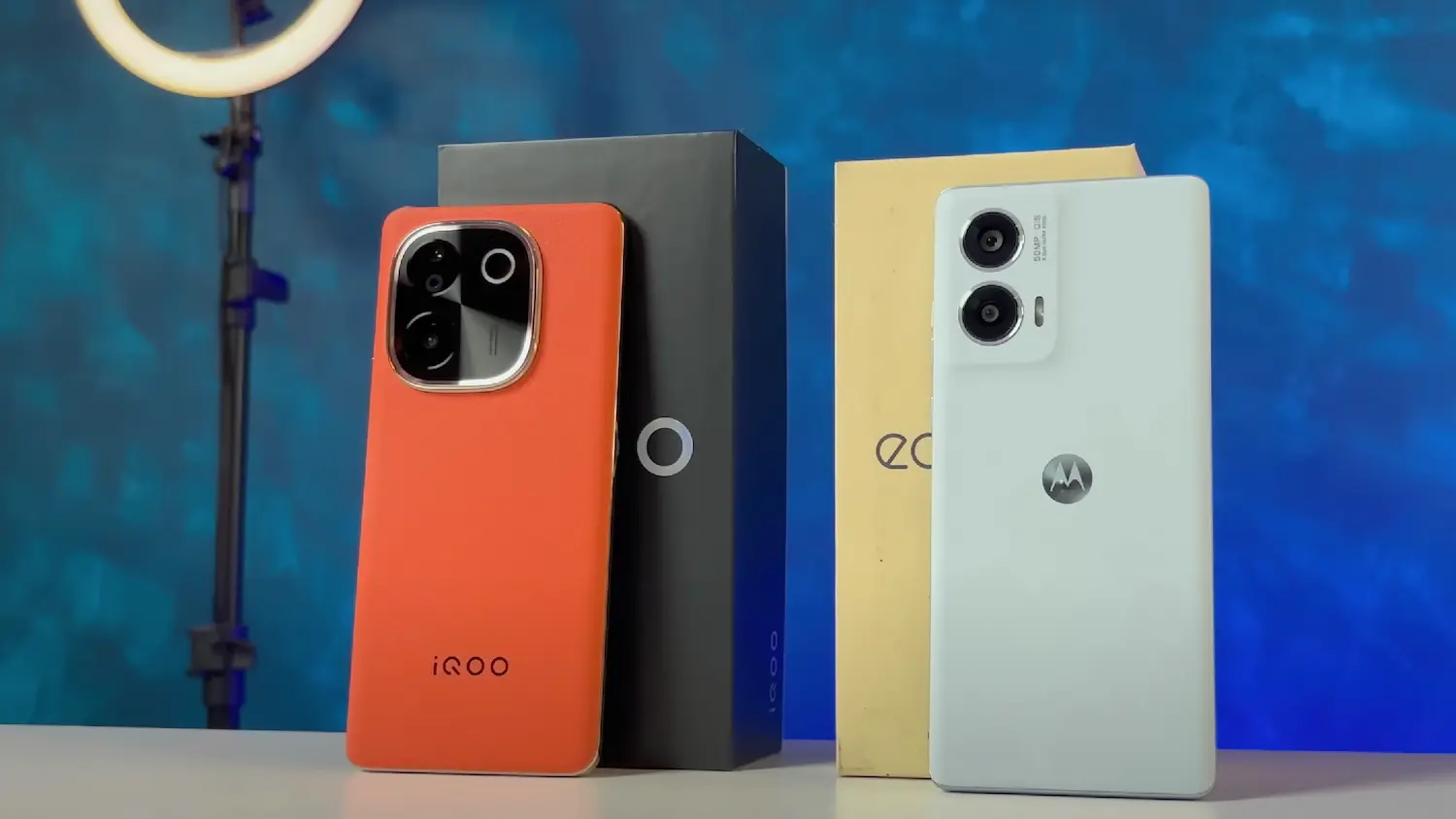
Putting the selfie camera aside, I prefer the IQOO when it comes to the primary lens and video recording. Motorola tends to display and images slightly boosted colors, which some might like while others may not, whereas IQOO offers a more natural color look. Performance-wise, there’s no doubt that IQOO outperforms Motorola significantly. In terms of battery, IQOO also provides better battery backup and more notable 80W fast charging compared to Motorola.
Overall, when comparing the two smartphones across 10 different aspects, IQOO Z9s Pro 5G wins in 7. If you’re a hardcore gamer or heavy user, IQOO is the better choice, but for normal usage, Motorola Edge 50 Fusion is also a solid option.
So, what are your thoughts on this comparison? If you had to choose between these two smartphones, which one would you pick? Don’t forget to share your experience in the comment below if you end up using either of them.
